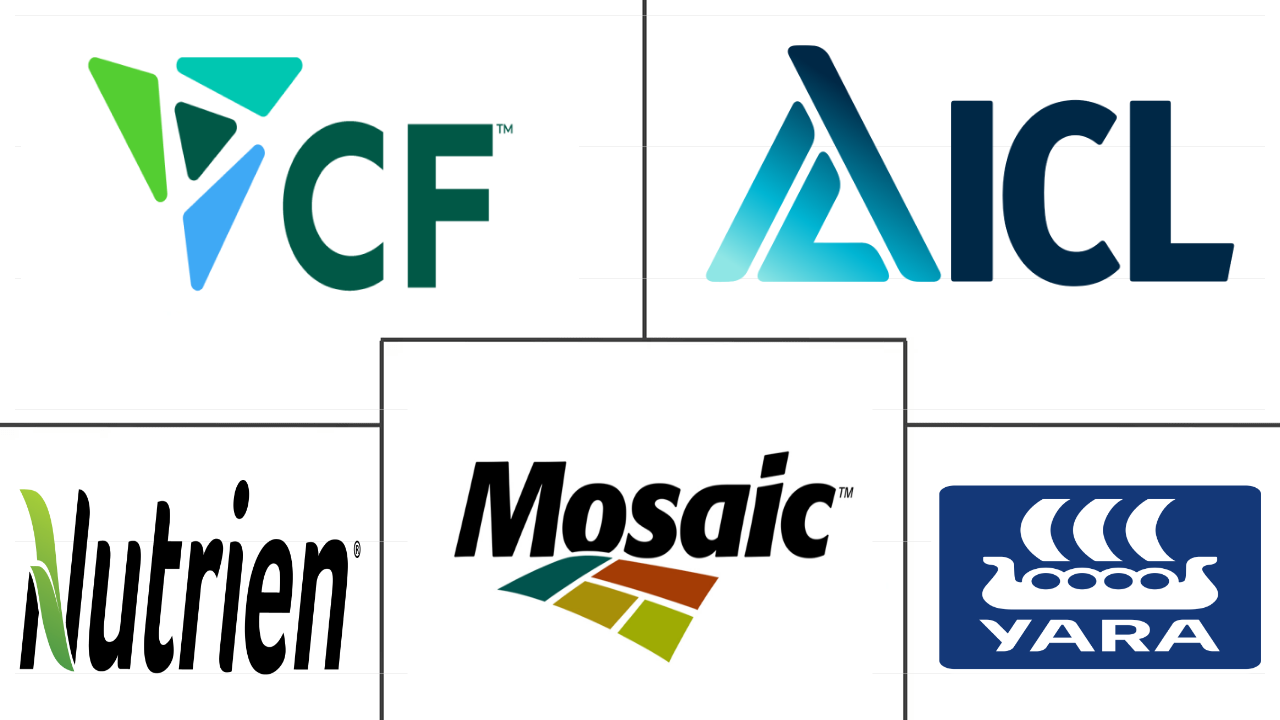Market Size of fertilizers Industry
| Icons | Lable | Value |
|---|---|---|
|
|
Study Period | 2017 - 2030 |
|
|
Market Size (2024) | USD 381.7 Billion |
|
|
Market Size (2030) | USD 541.2 Billion |
|
|
Largest Share by Crop Type | Field Crops |
|
|
CAGR (2024 - 2030) | 5.99 % |
|
|
Largest Share by Region | Asia-Pacific |
Major Players |
||

|
||
|
*Disclaimer: Major Players sorted in no particular order |
Fertilizers Market Analysis
The Fertilizers Market size is estimated at 381.7 billion USD in 2024, and is expected to reach 541.2 billion USD by 2030, growing at a CAGR of 5.99% during the forecast period (2024-2030).
381.7 Billion
Market Size in 2024 (USD)
541.2 Billion
Market Size in 2030 (USD)
6.87 %
CAGR (2017-2023)
5.99 %
CAGR (2024-2030)
Largest segment by Product
49.38 %
value share, Urea, 2023
Urea is the most predominantly used fertilizer globally which is attributed to its high nitrogen content of 46.0%, the highest among all the nitrogenous fertilizers.
Largest Segment by Crop Type
82.13 %
value share, Field Crops, 2023
The demand for fertilizers is higher in field crop segment due to their widespread use in large-scale agriculture to improve the yield and quality of the crops.
Fastest Growing Speciality Type
7.70 %
Projected CAGR, CRF, 2024-2030
The factors such as providing sustained and efficient nutrient supply to the plants and fewer nutrient losses are driving the demand for control-release fertilizers.
Largest segment by Country
14.09 %
value share, China, 2023
The country’s extensive cultivation of various crops to feed its large population contributes to a substantial need for fertilizers in Chinese agriculture sector.
Leading Market Player
4.73 %
market share, Yara International ASA, 2022

Yara International ASA engages in the production and distribution of different fertilizers. They have a range of products, that include coated, water-soluble, liquid, and complex fertilizers
Decreasing agricultural area is increasing the demand for fertilizers and is expected to drive the fertilizer market
- In 2022, field crops dominated the global fertilizers market, accounting for about 82.1% of the market value of the global fertilizer market, at about USD 353.9 billion. Field crop production is dominant worldwide, and more than 95.0% of the agricultural land in the world is under field crop cultivation. Rice, wheat, and corn are the major field crops produced globally, and these three crops account for about 38.0% of the global agricultural land.
- Horticultural crops account for about 15.0% of the total fertilizer market value worldwide. Horticultural crop production is dominant in developing countries, particularly in Asia-Pacific. Asia-Pacific's dominance in the global horticultural fertilizer market is primarily due to the presence of about 73.0% of the global horticultural cultivation area, which is about 137.66 million hectares of land under horticulture cultivation.
- The turf and ornamentals segment is the smallest fertilizer market, followed by horticultural crops. In 2022, the turf and ornamentals segment accounted for about 2.4% of the market value of the global fertilizer market, at about USD 10.42 billion. The turf and ornamental fertilizer market is a fragmented market. However, developed regions like North America and Europe occupy a major market share compared to Asia-Pacific and South America.
- Asia-Pacific dominates in growing both field and horticultural crops worldwide. The Asia-Pacific fertilizer market is growing at a fast rate. Europe is the second-largest fertilizer market, followed by Asia-Pacific. The increasing urbanization in many regions and the decreasing overall agricultural area are increasing the demand for fertilizers and are expected to drive the fertilizer market between 2023 and 2030.
Asia Pacific is dominating the global fertilizer market
- The global fertilizer market grew at a stable rate during the study period, registering a value of USD 429.0 billion in 2022.
- Asia-Pacific occupied the largest share of 44.8% in 2022, followed by Europe and South America. China is the largest producer and exporter of fertilizers in the region and the world, contributing 25% to global fertilizer production, according to the USDA. The Chinese fertilizer market is estimated to be valued at USD 70.3 billion in 2022, with a volume consumption of 94.2 million metric tons.
- North America accounted for 17.8% of the global fertilizer market in 2022. In North America, the United States and Canada constitute more than 90.0% of the fertilizer market's value and volume. Although North America has phosphate and potash resources, the region is a net importer of more than half of its nitrogenous fertilizers and over 85.0% of its potash from international sources.
- Europe accounted for 15.1% of the global fertilizer market in 2022. France is one of the largest fertilizer-consuming countries in Europe, with an expected overall share of 20.1% by the end of 2022. The market value is expected to reach USD 9 billion by the end of 2022, with a 5.8% y-o-y growth rate. The adoption of advanced cultivation methods will also increase the usage of specialty fertilizers.
- South America accounted for 11.2% of the market share in 2022. Field crops dominated the South American fertilizer market and accounted for 95% of the market share in 2022. The top three crops grown in South America are soybean, corn, and sugarcane.
- With the increasing cultivation of field crops, along with a subsequently increased demand for fertilizers, the market is anticipated to grow between 2023 and 2030.
Fertilizers Industry Segmentation
Complex, Straight are covered as segments by Type. Conventional, Speciality are covered as segments by Form. Fertigation, Foliar, Soil are covered as segments by Application Mode. Field Crops, Horticultural Crops, Turf & Ornamental are covered as segments by Crop Type. Asia-Pacific, Europe, Middle East & Africa, North America, South America are covered as segments by Region.
- In 2022, field crops dominated the global fertilizers market, accounting for about 82.1% of the market value of the global fertilizer market, at about USD 353.9 billion. Field crop production is dominant worldwide, and more than 95.0% of the agricultural land in the world is under field crop cultivation. Rice, wheat, and corn are the major field crops produced globally, and these three crops account for about 38.0% of the global agricultural land.
- Horticultural crops account for about 15.0% of the total fertilizer market value worldwide. Horticultural crop production is dominant in developing countries, particularly in Asia-Pacific. Asia-Pacific's dominance in the global horticultural fertilizer market is primarily due to the presence of about 73.0% of the global horticultural cultivation area, which is about 137.66 million hectares of land under horticulture cultivation.
- The turf and ornamentals segment is the smallest fertilizer market, followed by horticultural crops. In 2022, the turf and ornamentals segment accounted for about 2.4% of the market value of the global fertilizer market, at about USD 10.42 billion. The turf and ornamental fertilizer market is a fragmented market. However, developed regions like North America and Europe occupy a major market share compared to Asia-Pacific and South America.
- Asia-Pacific dominates in growing both field and horticultural crops worldwide. The Asia-Pacific fertilizer market is growing at a fast rate. Europe is the second-largest fertilizer market, followed by Asia-Pacific. The increasing urbanization in many regions and the decreasing overall agricultural area are increasing the demand for fertilizers and are expected to drive the fertilizer market between 2023 and 2030.
| Type | ||||||||||||||||||||||||||||||||||
| Complex | ||||||||||||||||||||||||||||||||||
|
| Form | ||||||
| Conventional | ||||||
|
| Application Mode | |
| Fertigation | |
| Foliar | |
| Soil |
| Crop Type | |
| Field Crops | |
| Horticultural Crops | |
| Turf & Ornamental |
| Region | |||||||||||||
| |||||||||||||
| |||||||||||||
| |||||||||||||
| |||||||||||||
|
Fertilizers Market Size Summary
The global fertilizer market is poised for significant growth, driven by increasing demand for high-yield crop production and the need to address soil deficiencies, particularly in iron. The market is characterized by a diverse range of products, with field crops dominating the sector due to their widespread cultivation and essential role as staple foods. The Asia-Pacific region leads in both field and horticultural crop production, benefiting from a large agricultural area and rapid urbanization, which fuels the demand for fertilizers. China stands out as the largest producer and exporter of fertilizers, while India, despite being a major producer, remains heavily reliant on imports to meet its growing consumption needs. The market is further supported by advancements in cultivation methods and the adoption of specialty fertilizers, which are designed to optimize nutrient release and minimize environmental impact.
The fertilizer market is fragmented, with a few key players holding a significant share. Companies like CF Industries, Israel Chemicals Ltd, Nutrien Limited, The Mosaic Company, and Yara International are at the forefront, engaging in strategic agreements to enhance their market presence. The North American region, particularly the United States, holds a substantial portion of the market value, driven by extensive agricultural land dedicated to field crops. In South America, the increasing area harvested for major food crops like soybean, corn, and sugarcane underscores the region's reliance on fertilizers. As the global population continues to rise and agricultural land diminishes, the demand for fertilizers is expected to grow, supporting the market's expansion during the forecast period.
Fertilizers Market Size - Table of Contents
-
1. MARKET SEGMENTATION (includes market size in Value in USD and Volume, Forecasts up to 2030 and analysis of growth prospects)
-
1.1 Type
-
1.1.1 Complex
-
1.1.2 Straight
-
1.1.2.1 Micronutrients
-
1.1.2.1.1 Boron
-
1.1.2.1.2 Copper
-
1.1.2.1.3 Iron
-
1.1.2.1.4 Manganese
-
1.1.2.1.5 Molybdenum
-
1.1.2.1.6 Zinc
-
1.1.2.1.7 Others
-
-
1.1.2.2 Nitrogenous
-
1.1.2.2.1 Ammonium Nitrate
-
1.1.2.2.2 Anhydrous Ammonia
-
1.1.2.2.3 Urea
-
1.1.2.2.4 Others
-
-
1.1.2.3 Phosphatic
-
1.1.2.3.1 DAP
-
1.1.2.3.2 MAP
-
1.1.2.3.3 SSP
-
1.1.2.3.4 TSP
-
1.1.2.3.5 Others
-
-
1.1.2.4 Potassic
-
1.1.2.4.1 MoP
-
1.1.2.4.2 SoP
-
1.1.2.4.3 Others
-
-
1.1.2.5 Secondary Macronutrients
-
1.1.2.5.1 Calcium
-
1.1.2.5.2 Magnesium
-
1.1.2.5.3 Sulfur
-
-
-
-
1.2 Form
-
1.2.1 Conventional
-
1.2.2 Speciality
-
1.2.2.1 CRF
-
1.2.2.2 Liquid Fertilizer
-
1.2.2.3 SRF
-
1.2.2.4 Water Soluble
-
-
-
1.3 Application Mode
-
1.3.1 Fertigation
-
1.3.2 Foliar
-
1.3.3 Soil
-
-
1.4 Crop Type
-
1.4.1 Field Crops
-
1.4.2 Horticultural Crops
-
1.4.3 Turf & Ornamental
-
-
1.5 Region
-
1.5.1 Asia-Pacific
-
1.5.1.1 Australia
-
1.5.1.2 Bangladesh
-
1.5.1.3 China
-
1.5.1.4 India
-
1.5.1.5 Indonesia
-
1.5.1.6 Japan
-
1.5.1.7 Pakistan
-
1.5.1.8 Philippines
-
1.5.1.9 Thailand
-
1.5.1.10 Vietnam
-
1.5.1.11 Rest of Asia-Pacific
-
-
1.5.2 Europe
-
1.5.2.1 France
-
1.5.2.2 Germany
-
1.5.2.3 Italy
-
1.5.2.4 Netherlands
-
1.5.2.5 Russia
-
1.5.2.6 Spain
-
1.5.2.7 Ukraine
-
1.5.2.8 United Kingdom
-
1.5.2.9 Rest of Europe
-
-
1.5.3 Middle East & Africa
-
1.5.3.1 Nigeria
-
1.5.3.2 Saudi Arabia
-
1.5.3.3 South Africa
-
1.5.3.4 Turkey
-
1.5.3.5 Rest of Middle East & Africa
-
-
1.5.4 North America
-
1.5.4.1 Canada
-
1.5.4.2 Mexico
-
1.5.4.3 United States
-
1.5.4.4 Rest of North America
-
-
1.5.5 South America
-
1.5.5.1 Argentina
-
1.5.5.2 Brazil
-
1.5.5.3 Rest of South America
-
-
-
Fertilizers Market Size FAQs
How big is the Global Fertilizers Market?
The Global Fertilizers Market size is expected to reach USD 381.71 billion in 2024 and grow at a CAGR of 5.99% to reach USD 541.16 billion by 2030.
What is the current Global Fertilizers Market size?
In 2024, the Global Fertilizers Market size is expected to reach USD 381.71 billion.

